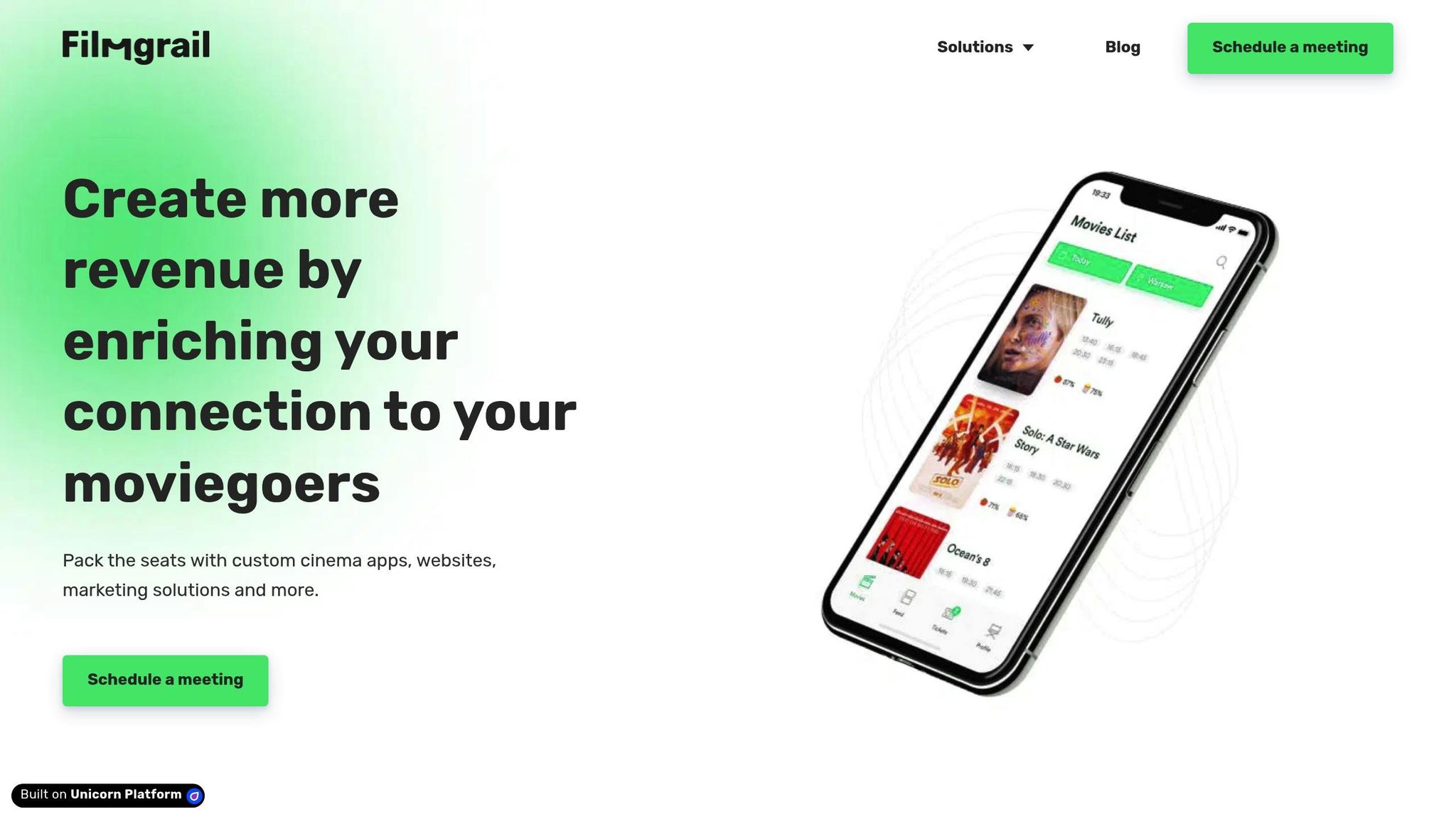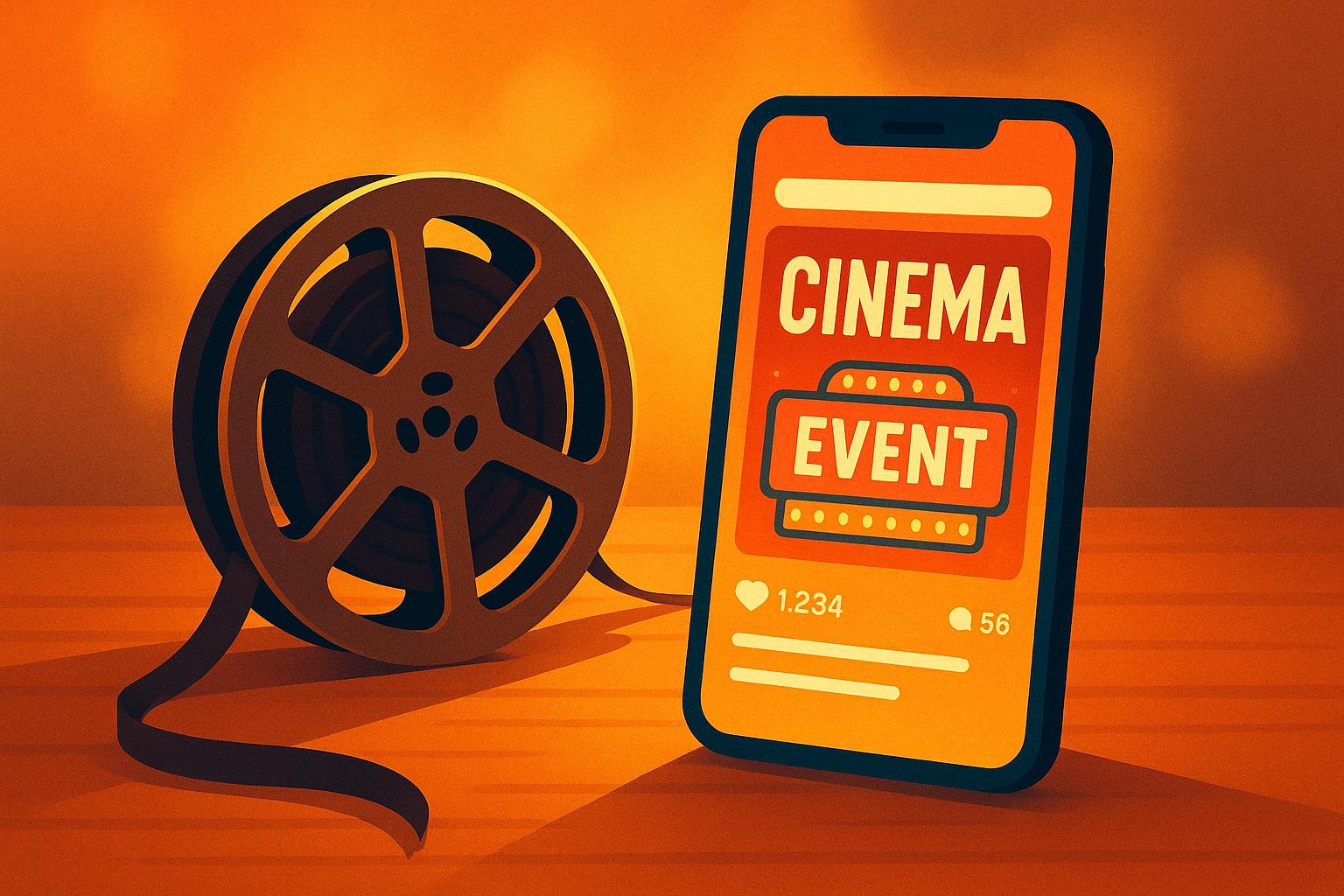When deciding on a mobile app for your cinema, the choice between cross-platform and native development is critical. Here's the breakdown:
- Cross-Platform Apps: Built with a single codebase for iOS and Android, they save costs (30–40%) and speed up development (25–50%). Ideal for cinemas prioritizing quick launches or tight budgets. However, they may face performance issues with complex features and limited access to advanced device capabilities.
- Native Apps: Designed specifically for iOS or Android, they offer superior performance, full device integration, and a tailored user experience. Perfect for cinemas requiring advanced features like biometric authentication or GPS-based promotions. They cost more (30–40% higher) and take longer to develop.
Quick Comparison
| Factor | Cross-Platform Apps | Native Apps |
|---|---|---|
| Performance | Good, but may lag with complex tasks | Excellent, optimized for each platform |
| Cost | 30–40% lower | Higher due to separate development teams |
| Time to Market | Faster (25–50% quicker) | Slower due to platform-specific builds |
| Device Integration | Limited, requires workarounds for some features | Full access to all device features |
| User Experience | Consistent across platforms | Tailored to iOS and Android design standards |
| Maintenance | Easier with shared updates | More complex, separate updates for each platform |
Key Takeaway: Choose cross-platform for cost efficiency and speed. Opt for native if performance, advanced features, or scalability are priorities.
Cross-Platform vs Native: What's Best for Your App in 2024?
What Are Cross-Platform Apps for Cinemas
As we've discussed, app performance plays a crucial role in driving ticket sales and audience engagement. Cross-platform apps offer a solution that balances performance with cost efficiency. These apps are built on a single codebase and optimized to work across multiple operating systems, primarily iOS and Android. For cinemas, this means you can develop one app that serves users on both platforms, eliminating the need to create separate applications for each.
Using frameworks like React Native, Flutter, or Xamarin, developers can write the app's code once and deploy it across platforms. These frameworks either translate the shared code into native components or use rendering engines to ensure compatibility. Think of it as a master blueprint that adjusts itself to fit each device. This approach enables faster development and reduces costs without sacrificing functionality.
For cinema businesses, cross-platform apps deliver the features moviegoers expect: movie schedules, ticket purchasing, seat selection, loyalty rewards, and push notifications. Some advanced apps even include auto-playing trailers, video stories, and tailored notifications, all designed to work seamlessly on any device.
Technological advancements have significantly improved cross-platform app performance. These apps are now compiled into native code, allowing them to offer near-native speed and access to most device features. This ensures a smooth and responsive experience, whether a customer uses an iPhone 15 or a Samsung Galaxy.
Benefits of Cross-Platform Apps
Cost savings are one of the biggest advantages. Developing a cross-platform app can save you 30-40% compared to creating separate native apps for iOS and Android. Instead of hiring two teams or doubling your workload, you can invest in a single solution that serves all your users.
Faster time to market is another key benefit. With cross-platform development, you can launch apps for both platforms up to 50% faster. Whether you're promoting a new blockbuster or rolling out a holiday campaign, updates can reach all users simultaneously.
Simplified maintenance makes operations easier. Bug fixes, updates, and new features can be implemented across all platforms at once. For example, if you need to address a payment issue or introduce a new feature, you only need to do it once, rather than managing separate updates for iOS and Android.
Consistent branding ensures a uniform user experience. Whether someone is booking tickets on an iPhone or an Android device, they'll encounter the same design, functionality, and quality. This consistency enhances brand recognition and minimizes user confusion.
Streamlined development reduces complexity. Working with a single development team that handles the entire app simplifies project management. Communication becomes more straightforward, leading to quicker problem-solving and faster implementation of new features.
While cross-platform apps offer many advantages, they do come with certain limitations.
Drawbacks of Cross-Platform Apps
Performance issues can arise in specific scenarios. Cross-platform apps may lag behind native apps when it comes to handling graphics-heavy features or complex animations. If your cinema app relies on high-quality video content or intricate visual effects, users might experience slight delays or reduced smoothness.
Limited access to device features can be a challenge. Although modern frameworks support most functions, integrating advanced features like biometric authentication, NFC ticketing, or custom camera functionalities might require additional workarounds. These limitations could affect specialized features you want to include.
Additional native coding may sometimes be necessary. If your app requires deep integration with device hardware or cutting-edge features, developers might need to write native code to fill gaps in the cross-platform framework. This hybrid approach can add complexity and reduce some of the benefits of unified development.
Framework dependency poses potential risks. Your app's capabilities depend on the chosen framework's updates and support. If the framework lags in adopting new operating system features, your app might face delays in offering the latest iOS or Android functionalities.
Challenges with platform-specific design can impact user experience. iOS and Android users have unique expectations for interface design and interaction. Cross-platform apps may struggle to fully align with these platform-specific conventions, potentially making the app feel less intuitive for some users.
What Are Native Apps for Cinemas
Native apps for cinemas are specifically built for a single platform, using the platform's native programming languages and tools. For example, iOS apps are developed with Swift or Objective-C, while Android apps use Kotlin or Java. These apps are tailored for their respective platforms and are distributed through the App Store for iOS devices and Google Play for Android devices.
Unlike cross-platform solutions that rely on a shared codebase, native apps are designed to fully integrate with the unique features and design conventions of their operating systems. An iOS app, for instance, feels right at home on iPhones and iPads, while an Android app aligns with the Material Design principles that Android users expect. This platform-specific approach ensures better performance and a more seamless user experience.
One of the biggest advantages of native apps is their ability to access hardware and operating system features directly. This makes it possible to include functionalities like biometric authentication for secure logins, camera access for scanning tickets, and GPS for location-based promotions. While creating separate apps for iOS and Android requires specialized teams and a higher investment, this approach unlocks the full potential of each platform, leading to better performance and smoother integration.
These benefits make native apps a compelling choice for cinemas.
Benefits of Native Apps
Faster performance and responsiveness: Native apps run directly on the operating system, delivering quick load times, smooth animations, and a responsive interface. This is especially important for features like ticket selection and payment processing, where speed and reliability are critical.
Full access to device features: Native apps can take advantage of advanced capabilities like using the camera for ticket scanning, GPS for location-based notifications, and push notifications for personalized movie recommendations. They also support features like biometric authentication for secure logins and one-tap checkout with mobile payment options, helping to reduce cart abandonment.
Platform-specific design and usability: By following platform-specific guidelines - like Apple’s Human Interface Guidelines for iOS and Material Design for Android - native apps feel familiar and intuitive to users. This natural fit enhances user engagement.
Stronger security: Native apps benefit from the built-in security features of their operating systems, such as encryption and fraud detection. They also allow for faster implementation of security updates, reducing the risk of vulnerabilities.
Quick adoption of new OS features: When Apple or Google release new features - like updated payment systems or enhanced notifications - native apps can integrate these updates immediately, keeping the app up-to-date without relying on third-party frameworks.
Major cinema chains in the U.S., such as AMC Theatres and Regal Cinemas, use native apps to integrate loyalty programs, support platform-specific payment methods, and deliver targeted push notifications. These efforts have boosted ticket sales and improved customer retention by providing a better overall experience.
Drawbacks of Native Apps
Higher development costs: Building separate apps for iOS and Android typically costs 30–40% more than cross-platform solutions because each platform requires its own specialized team.
Longer development timelines: Maintaining separate codebases means that adding new features, fixing bugs, or rolling out updates takes more time and effort. This can delay the release of new features or promotional updates.
Complex maintenance: Every update or fix - whether it’s for payment processing or loyalty features - has to be implemented and tested separately for each platform. This increases operational complexity and the risk of inconsistencies between the two versions.
Resource challenges: Managing multiple teams with expertise in different programming languages and quality assurance processes can be difficult, especially for smaller cinema chains with limited resources.
Feature rollout delays: With separate codebases, prioritizing one platform over the other can lead to delays and feature disparities. This can frustrate users if one platform gets updates or new functionality before the other.
Cross-Platform vs. Native Apps: Side-by-Side Comparison
Deciding between cross-platform and native development for your cinema app means weighing how each option performs in areas like performance, cost, and functionality. Here's a breakdown of the key factors to help you make an informed choice.
Comparison Table: Key Factors
| Factor | Cross-Platform Apps | Native Apps |
|---|---|---|
| Performance | Delivers good performance but may struggle with complex tasks like streaming trailers or managing high ticket volumes | Offers top-notch performance, optimized for each platform with faster load times and smoother animations |
| Development Cost | Costs are 30–40% lower due to a single codebase and shared development team | Higher costs since separate teams are needed for iOS and Android |
| Time to Market | Launches up to 50% faster with simultaneous deployment on both platforms | Takes longer to develop because each platform requires its own build |
| User Experience | Consistent design across platforms, though it might lack the polish specific to each platform | Provides a superior experience tailored to iOS and Android design standards |
| Device Integration | Accesses most features via plugins, but new capabilities may take time to implement | Fully integrates with all device features, including biometric authentication and camera scanning, right away |
| Maintenance | Easier with updates applied across platforms simultaneously | More complex, as updates and testing must be done separately for each platform |
| Cinema Features | Handles basic ticketing and loyalty functions but may need additional native code for advanced features | Fully supports advanced systems like complex ticketing, loyalty programs, and personalized recommendations |
| Security | Offers good security but is slower to adopt the latest platform updates | Provides stronger security with quicker implementation of OS-level encryption and fraud detection |
During peak times, like opening weekends or special promotions, cross-platform apps might experience slowdowns with heavy ticket processing, while native apps generally maintain smooth performance.
Cost and Long-Term Value
Initial development costs for cross-platform apps are lower, making them appealing for businesses with tighter budgets. However, native apps often deliver better long-term value thanks to higher user retention and increased conversion rates. These factors should weigh heavily in your decision-making process.
How to Use This Comparison for Your Cinema
To choose the right development approach, start by identifying your business priorities. If getting your app to market quickly and at a lower cost is your top goal, cross-platform development is the way to go. This option is especially useful for cinemas testing new markets or independent theaters working with limited resources.
On the other hand, if your app needs advanced functionality - like intricate ticketing systems, robust loyalty programs, or personalized recommendations - native development is a better fit. Moviegoers often expect premium experiences from cinema apps, especially those who are accustomed to polished interfaces and seamless performance on major entertainment platforms. If your target audience values these details, native apps can help you build brand loyalty.
While cross-platform apps save money upfront, native apps, though 30–40% more expensive, can boost revenue by reducing cart abandonment and improving user engagement.
Your timeline also matters. Cross-platform development allows for simultaneous launches, which is a big advantage during competitive seasons or promotional events. Native development, while slower, can give you more control over platform-specific marketing strategies, such as featuring your app in targeted campaigns.
Finally, assess your technical team’s expertise. Cross-platform development requires proficiency in tools like React Native or Flutter, while native development demands specialized knowledge in iOS and Android. Whether you plan to build in-house or hire external developers, make sure your team has the right skills for the job.
sbb-itb-b1b0647
Which App Type Should Your Cinema Choose
Deciding between cross-platform and native app development comes down to your cinema's specific needs, resources, and goals. Budget often plays a big role - cross-platform development can cut costs by 30–40% and speed up launch times by 25–50% compared to building separate native apps for iOS and Android. On the other hand, native apps can deliver better long-term results with higher user retention and conversion rates.
To make the right choice, focus on your technical requirements. If your app's main purpose is basic functionality - like ticket sales, showtime listings, or loyalty programs - cross-platform apps are a strong option. But if your cinema needs advanced features that rely heavily on smartphone capabilities, native development might be the way to go.
Here’s a closer look at when each approach works best.
When Cross-Platform Apps Work Best
Cross-platform development shines when you're working with tight budgets or deadlines. Smaller cinemas or independent theaters often choose this route for their first mobile app because it’s cost-effective and quick to deploy.
With a shared codebase, you only need to build one app that works on both iOS and Android. This saves money and reduces the complexity of managing separate projects. It’s a great option if your main goal is to establish a mobile presence without diving into specialized features.
Speed is another big advantage. Whether you're preparing for a grand opening, launching a film festival, or responding to changing market trends, cross-platform development allows you to move quickly. Plus, these apps provide a consistent user experience across devices, and updates or bug fixes are easier to manage since changes only need to be made once. This streamlined maintenance makes it simpler to roll out new features or promotions.
When Native Apps Work Best
If performance is a top priority, native development is the better choice. Native apps handle high traffic, complex transactions, and smooth video playback more effectively, making them ideal for cinemas expecting heavy app usage during peak times.
Native apps also excel at advanced device integrations. Features like biometric authentication for loyalty programs, camera-based ticket scanning, GPS-based services, and custom push notifications work more reliably in a native environment. This ensures a polished experience for frequent moviegoers.
Another advantage of native apps is their ability to fully align with each platform's design guidelines. This platform-specific approach can improve user satisfaction and keep customers coming back.
As your cinema grows - whether by adding new locations or integrating advanced features like multi-location loyalty programs, detailed analytics, or sophisticated point-of-sale systems - native apps are better equipped to scale with your needs. They’re also a smart choice for security-sensitive tasks like payment processing or managing customer data, as they can quickly adopt the latest operating system-level security updates.
Ultimately, your decision should align with your cinema's priorities. Cross-platform development is ideal when speed and cost are top concerns, while native development is better suited for delivering high performance, advanced features, and seamless device integrations.
How Filmgrail Delivers Both App Types for Cinemas

Filmgrail takes a flexible approach to app development, offering both cross-platform and native solutions to cater to the varied needs of cinemas. This strategy allows cinemas to strike the right balance between cost-effectiveness, performance, and audience engagement, while also focusing on features that boost ticket sales.
Filmgrail's Development Options
Filmgrail works closely with cinemas to determine the best development strategy for their goals. For cross-platform apps, Filmgrail uses trusted frameworks that enable a single codebase to function smoothly on both iOS and Android devices. This option is ideal for cinemas looking to launch quickly or working within tighter budgets.
On the other hand, when cinemas require top-tier performance or platform-specific capabilities, Filmgrail develops native apps tailored to each operating system. This approach ensures full access to device-specific features and the latest updates, making it perfect for advanced functionalities like NFC ticketing or augmented reality experiences.
Every app undergoes rigorous testing to ensure it performs efficiently, looks polished, and provides an intuitive user experience. By adhering to platform-specific guidelines, Filmgrail delivers apps that not only run seamlessly but also captivate users.
What sets Filmgrail apart is its consultative approach. Instead of offering a one-size-fits-all solution, the team evaluates factors like a cinema's brand identity, user experience goals, and operational needs. This thoughtful process ensures each app is tailored to drive meaningful engagement, a hallmark of Filmgrail's work.
Filmgrail's Engagement Features
Filmgrail apps are designed to do more than just sell tickets - they create meaningful connections with moviegoers, encouraging repeat visits and long-term loyalty.
Auto-playing trailers grab attention and generate excitement for upcoming releases, while video stories turn the app into a dynamic entertainment hub rather than just a transactional tool.
The targeted push notification system ensures that users receive relevant updates. For instance, when someone adds a movie to their watchlist, they’ll get notifications about showtimes, limited screenings, or last-chance opportunities. These messages feel personalized and helpful, rather than intrusive.
Local audience reviews and ratings add a community-driven aspect to the app, encouraging users to engage with feedback from fellow moviegoers in their area. This not only builds trust but also drives ticket sales by creating a sense of shared experience.
The impact of these features is clear. Cinemas using Filmgrail's solutions report four times higher engagement than industry standards, alongside an impressive 89% annual growth in digital ticket sales. Additionally, nine out of ten users create unique profiles, giving cinemas valuable insights for crafting personalized marketing campaigns.
"Filmgrail has played a determining role in helping us grow our mobile presence and providing an outstanding moviegoing experience beyond the big screen."
- Daniel Eikeland, Sales & Service Manager, Bergen Kino
Filmgrail's platform also boosts revenue beyond ticket sales. Through in-app promotions, cinemas can upsell concessions, merchandise, and premium experiences. Meanwhile, a robust analytics dashboard tracks key metrics - such as app downloads, active users, trailer engagement, and push notification performance - empowering cinemas to refine their strategies and maximize results.
Conclusion: Choosing the Right App Development Approach
Deciding between cross-platform and native app development comes down to aligning your tech strategy with your cinema's specific goals and how you want to engage your audience. Both approaches can achieve outstanding results when they fit your business needs.
For cinemas looking to launch quickly and affordably on both iOS and Android, cross-platform development offers a practical solution. It can cut costs by about 40% and speed up time-to-market by as much as 50%. This makes it a great choice for cinemas prioritizing core features like showtimes, ticketing, and basic notifications. However, if your app requires more advanced capabilities, the deeper integration of native development might be a better fit.
Beyond cost and speed, delivering an engaging user experience is critical. If your cinema plans to offer advanced features - such as augmented reality for seat selection, sophisticated loyalty programs, or high-quality promotional content - native app development provides the performance and device integration needed to bring these ideas to life. While this approach typically requires a larger upfront investment and separate development for each platform, the payoff is a polished, high-performing app that can significantly enhance customer satisfaction.
Modern cinemas rely on features like personalized notifications, local reviews, and immersive content to connect with their audience. Apps that successfully implement these elements often see strong growth in digital ticket sales.
Filmgrail supports both cross-platform and native development, offering solutions packed with proven engagement tools. Their expertise has shown impressive results, including four times more moviegoer engagement compared to industry standards. By combining the right technology with features designed specifically for cinemas, Filmgrail helps drive ticket sales and build lasting relationships with customers.
FAQs
What should cinemas consider when deciding between cross-platform and native app development?
When choosing between cross-platform and native app development, cinemas should weigh factors that directly influence both the user experience and their business objectives. These factors include development costs, time to launch, app performance, and how well the app can deliver a smooth experience for moviegoers.
Native apps are known for offering better performance and deeper integration with device-specific features, which can elevate the overall moviegoing experience. In contrast, cross-platform apps are often more budget-friendly and quicker to develop, making them a smart option for cinemas aiming to connect with a larger audience in less time.
Filmgrail specializes in crafting tailored cinema mobile apps and solutions designed to engage users and streamline the checkout process. Their tools help cinemas strengthen their brand, increase ticket sales, and provide memorable experiences for their customers.
How do cross-platform apps compare to native apps when it comes to features like biometric authentication or location-based promotions?
When it comes to advanced features like biometric authentication (think fingerprint or facial recognition) and GPS-based promotions, cross-platform apps can handle them - but how they’re implemented depends heavily on the framework you choose. Native apps, built specifically for iOS or Android, offer seamless integration with device-specific features. In contrast, cross-platform apps rely on shared codebases, which may need extra tweaks to deliver the same level of performance and reliability.
For cinemas, the decision between native and cross-platform apps often boils down to user experience and budget. Native apps shine when it comes to leveraging device-specific capabilities, offering smooth and responsive performance. However, they come with higher development costs and longer timelines. Cross-platform apps, on the other hand, are quicker to launch and more budget-friendly for covering multiple platforms, though replicating native-level functionality might take additional effort. If your aim is to connect with moviegoers while keeping costs in check, carefully weigh which option best fits your business priorities.
What are the long-term advantages of choosing native app development over cross-platform development for cinemas?
Native app development brings a range of long-term perks for cinemas aiming to strengthen their digital presence and connect more effectively with moviegoers. One of the standout benefits is performance and user experience. Since native apps are designed specifically for either iOS or Android, they deliver smoother performance, faster load times, and more seamless interactions. This often translates to happier users who are more likely to stick around.
Another major plus is the ability to tap into device-specific features like GPS, cameras, and push notifications. These tools allow cinemas to craft personalized experiences for their audience - think location-based promotions or reminders about upcoming movies. These tailored touches not only enhance engagement but also help foster loyalty and boost ticket sales over time.
Although the upfront costs of native app development can be higher, the long-term reliability and scalability make it a smart investment. For cinemas focused on providing a top-tier experience and building their brand, native apps can be a powerful tool to achieve those goals.


